skip to main |
skip to sidebar
I may have mentioned once or twice or a few dozen times that, or the first 30 or so years of my life, I hated parakkai (also known as pavakkai, karela, bittermelon or bittergourd - or, if you're my husband, as "green rats"). If you're a karela lover, today's recipe will be right up your street. If you're not a karela lover, this recipe will still be quite a way up your street because you will not taste the bitterness from the vegetable at all.
If you know your karela at all, you would think it's hard to mask the bitterness, but because everything is roasted and there are lots of other ingredients, the resultant powder has no discernible bitterness. At least, none that I could taste. And I didn't even peel the skin or discard the seeds (although if they're red and hard, DO scoop them out and discard) or salt the cut bittergourd to reduce the bitterness. Because I'm lazy and that's the way I roll, baby.
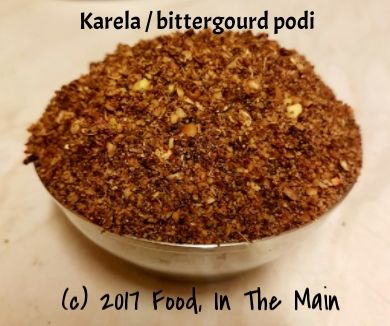
I ate this mixed with rice and ghee, I ate it sprinkled over roasted vegetables, I ate it as a side with kootu and roti, I ate it mixed with yogurt both as a dip and as a salad dressing - it's my most favourite thing at the moment, and it seems to work with everything.
Best of all, since the karela is oven roasted with only a mimimal amount of oil, it's a healthy podi. There are versions where the vegetable is deep fried until crisp, but - while I love deep fried foods with a deep and abiding love - I see no need to load this podi with unnecessary calories.
Recipe for: Bittergourd / pavakkai / karela podi
Ingredients:

3-4 medium size tender karela
10 dried red Kashmiri chillies
2 tbsp coriander seeds
2 tbsp whole urad dal
2 tbsp chana dal
2 tbsp kollu or horsegram
2 tbsp fresh or frozen grated unsweetened coconut
1 tbsp black sesame seeds (regular will probably also do)
Handful of curry leaves (fresh or frozen)
2-3 cloves of garlic, halved
1 small gooseberry sized ball of tamarind (seeds and strings removed if any)
1/2 tsp asafoetida powder
1/2 tsp + 1 tbsp oil
Salt to taste (or about 1.5 tsp)
Method:
1. Thinly slice the karela, mix with 1 tbsp oil and roast in a 180C/350F oven until the slices are brown with very little green showing. This should take about 30 minutes, but be sure to stir them around every 10 minutes so that they crisp evenly. Let them cool completely.
2. Heat the oil in a wok and add the red chillies. Roast on a medium-low flame, stirring often until the chillies turn a darker shade, about 5 minutes. Be careful not to burn them or you'll regret the fumes! Remove to a plate and cool.
3. Add the coriander seeds, the sesame seeds and all the dals. Dry roast them, stirring often, until they are toasted and fragrant, and turn a darker shade. Again, don't burn them or the podi will taste bitter. Add to the roasted chillies and let cool.
4. Finally, add the coconut, curry leaves, garlic and tamarind and toast in the pan, stirring frequently, until the coconut has turned golden brown and has no more moisture in it - yet again, be careful not to burn it.
5. Once all the ingredients are cool, grind them into a slightly coarse powder. Add salt and asafoetida powder and mix well. Store in an airtight container.
I simply had to post this kuzhambu recipe, because it is just literally so lip-smackingly good - thick, tangy, hot, spicy, a tiny bit sweet and entirely irresistible! The recipe is from a foodie group on Facebook of which I am a member, and I can't seem to find it again on FB (which I wanted to do for crediting purposes on my blog). I am SO pleased that I wrote it down on a piece of paper when I saw it on FB (not having had access to a printer or my own computer at that point). I state freely that this is not my own recipe, and I do really wish I knew whose it was. All I DO know for certain that it is comfort food whose ingredients are good for health.
I made the kuzhambu and refrigerated it just before going on a week-long trip on a narrowboat with my husband. It was a lovely, relaxing, stressfree holiday, with the most gorgeous, eye-poppingly pretty scenery... but that's only by the way. The main thing is, I knew that the food I would be eating on the boat (and off it, at the various canal-side pubs that we stopped at) would not be spicy enough for me, and I would be dying for something to tickle my palate when we got back.
And so it turned out.
I certainly enjoyed the food en route, but I couldn't wait to get stuck into hot and spicy comfort food when we got home - and this kuzhambu was absolutely just the thing. I could not have asked for anything better. All I had to do was make some rice - and because it was too late to make any vegetable side-dish to accompany it (and because I was much too hungry), I just microwaved a couple of poppadoms and ladled the kuzhambu on the rice. It tasted like heaven - but there was rather too much of the kuzhambu on the rice, because it was so full-on hot and peppery. It's really meant to be mixed with rice in small amounts, not in quantities like regular sambar or rasam. I had to tone the spice quotient down somewhat with a large dollop of Greek yogurt on the side of my plate, but that was a wonderful combination anyway.
Oh, and if you're wondering why I didn't mention the taste of the large amounts of garlic that went into the kuzhambu, it's because it doesn't come across as overly garlicky. So don't worry about it, and don't skimp on the garlic; in fact, next time I will probably add even more garlic. It's good for you, anyway, so no harm done.
One other thing - the correct amount of salt is essential, otherwise the kuzhambu tends to be on the sweetish side. I'm used to making do with less salt in my cooking than (after all, you can always add more, but you can't really undo oversalting disasters!) but in this case I did have to add some more. So, it would probably be best to start by adding 3/4 tsp salt, then taste-testing to see if your palate requires more. Let your tongue and palate be the judge.
Happy eating!
Recipe for: Black pepper garlic kuzhambu
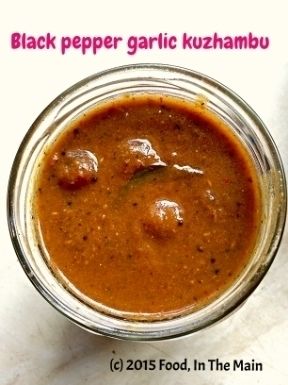
Ingredients:
1/4 cup baby shallots/sambar onions
1 tbsp tamarind paste, dissolved in 1/2 cup water
1/2 tsp turmeric powder
1 tsp jaggery (raw palm sugar) (optional)
1 tbsp neutral oil
Salt to taste
To grind:
1-2 tsp black peppercorns (more if you love your black pepper)
6-8 dried red chillies
1 whole head of garlic (about 1/8 cup garlic cloves, peeled and chopped into chunks if very large)
2 tsp cumin seeds
1 medium onion
1 medium tomato
3 sprigs curry leaves
To temper:
1 tbsp nallennai (unrefined sesame oil)
1/2 tsp vendhayam (methi/fenugreek seeds)
2 tsp mustard seeds
10 curry leaves
Method:
1. Heat 1/2 tbsp oil in a small pan and add the first four items on the "To grind" list. Saute for 2-3 minutes on med-high, stirring, until the chillies turn a darker shade of red and the garlic is starting to turn colour. Then add the remaining ingredients and fry until the garlic is golden. Allow to cool, then grind to a smooth paste. Set aside till required.
2. Heat the remaining neutral oil, add the small onions and fry till golden (approx 3-4 minutes). Add the tamarind water, salt to taste, turmeric and jaggery. Bring it to a boil and let it bubble for 2 minutes.
3. Now add the ground paste and 2 cups water and mix well. Bring to a boil again and let it simmer for 10 minutes, or until it is thick enough to coat the back of a spoon.
4. As a final touch, heat the nallennai in a small pan, then add the mustard seeds and curry leaves. Cover and let the mustard seeds pop. Now tip in the fenugreek seeds and fry for 30 seconds or until the seeds turn a darker shade of brown. Be careful not to burn the seeds or they will be horribly bitter. Pour the tempering over the kuzhambu and stir it in. Let it simmer for another 3 minutes, then take the pan off the heat.
Serve sparingly over steamed white rice with a dollop of ghee, any dry vegetable curry and microwaved poppadoms.
This gorgeous emerald coloured chutney is many kinds of pretty - pretty beautiful, pretty tasty, pretty versatile, pretty healthy, pretty easy to make...
So go and make it. Pretty please.
Recipe for: Spinach-onion-cabbage chutney

Ingredients:
1 cup spinach leaves
1/2 cup cabbage, sliced
1 medium onion, sliced
A good handful of chives
2 cloves garlic, sliced
1 tbsp oil
2 tsp urad dal
1 tsp tamarind paste or a gooseberry sized piece of tamarind
5-6 dried red chillies (or to taste)
1/4 tsp asafoetida powder (optional)
2 tsp mustard seeds
4-5 fresh or frozen curry leaves
Salt to taste
Method:
1. Heat the oil and when it shimmers, add the mustard seeds and cover the pan till they finish popping.
2. Now add the urad dal, red chillies, curry leaves and asafoetida powder. Stir-fry till the urad dal turns a pale golden brown and the red chillies are a shiny darker shade.
3. Add the garlic, chives and onion and stir-fry till the onions start to soften and turn translucent.
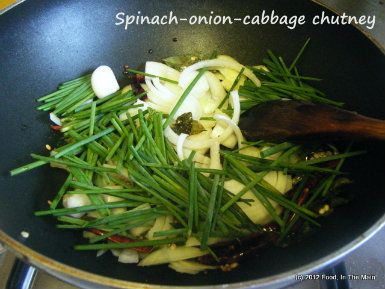
4. Add the cabbage and fry it till it wilts,
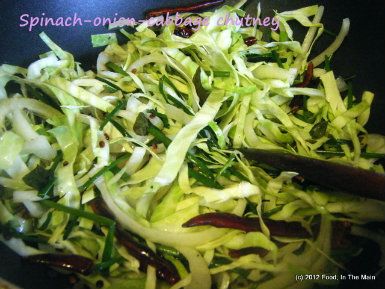
then the spinach until it wilts too.

Let this mixture cool.
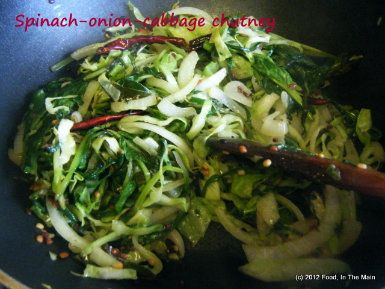
5. Pick out the red chillies and grind them to a smooth paste with the tamarind and a couple of spoonfuls of the vegetable mixture.
6. Now add the rest of the cabbage-onion-spinach mix
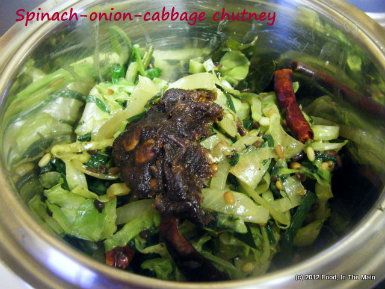
and grind it to a fairly smooth consistency - but not to a puree. It should be a little bit coarse.
7. Remove the chutney to a bowl, add salt to taste and mix well. This can be mixed with rice or eaten as a side dish/dip with chapaties, dosas, idlis etc.
RECIPE: SPINACH-ONION-CABBAGE CHUTNEY
Ingredients:
1 cup spinach leaves
1/2 cup cabbage, sliced
1 medium onion, sliced
A good handful of chives
2 cloves garlic, sliced
1 tbsp oil
2 tsp urad dal
1 tsp tamarind paste or a gooseberry sized piece of tamarind
5-6 dried red chillies (or to taste)
1/4 tsp asafoetida powder (optional)
2 tsp mustard seeds
4-5 fresh or frozen curry leaves
Salt to taste
Method:
1. Heat the oil and when it shimmers, add the mustard seeds and cover the pan till they finish popping.
2. Now add the urad dal, red chillies, curry leaves and asafoetida powder. Stir-fry till the urad dal turns a pale golden brown and the red chillies are a shiny darker shade.
3. Add the garlic, chive and onion and stir-fry till the onions start to soften and turn translucent.
4. Add the cabbage and fry it till it wilts, then the spinach until it wilts too. Let this mixture cool.
5. Pick out the red chillies and grind them to a smooth paste with the tamarind and a couple of spoonfuls of the vegetable mixture..
6. Now add the rest of the cabbage-onion-spinach mix and grind it to a fairly smooth consistency - but not to a puree. It should be a little bit coarse.
7. Remove the chutney to a bowl, add salt to taste and mix well. This can be mixed with rice or eaten as a side dish/dip with chapaties, dosas, idlis etc.
You know, it's really nice not to be the proverbial frog in the well, and it's all the hundreds of food blogs that I have to thank for introducing me to the enticing, amazing world of home-style food recipes... and showing me the thousands of possibilities with everyday vegetables and fruit that would never have occurred to me otherwise.
Take thogayal, for instance - I knew three kinds: Coconut-only, coconut-with-cabbage, and coconut-with-pumpkin-or-chayote squash. I didn't even imagine that thogayal could be made with carrots, beets, bell peppers, spinach, etc... and as for making it without coconut - wow! The first time I made thogayal with just cabbage was such a revelation! All the taste of the dish I loved without loading it up with coconut - I can't tell you how much I loved it.
In that spirit, I decided to make thogayal with a bunch of red radishes with their greens because I didn't feel like eating them raw (they were pretty pungent!).
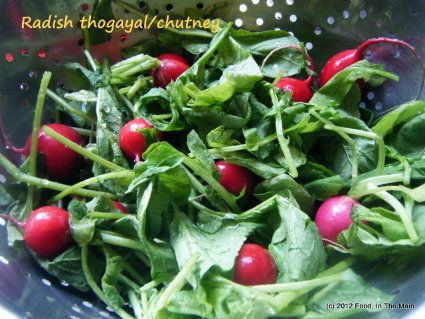
I was actually a bit worried that the thogayal would be smelly... but as it turned out, you would not have known that it was made with radishes, because the typical smell of the radishes was totally gone. I'm absolutely certain that even radish haters would love this chutney. You could probably even try it with the more typically Indian white radish or mooli - I'm going to do so if and when I get my hands on some. But until then, red radish thogayal will fill its place perfectly.
Recipe for: Radish thogayal/chutney
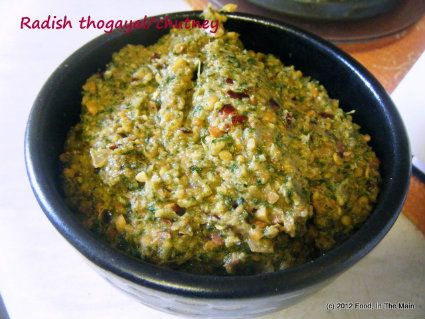
Ingredients:
10-12 small red radishes or 1 medium white mooli/radish, chopped
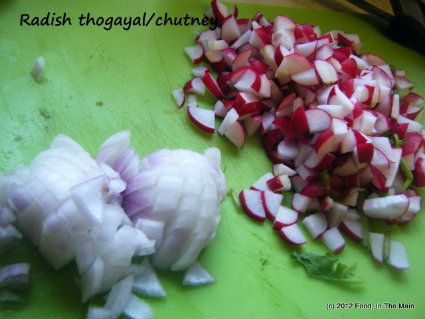
1 cup radish greens (or use spinach) (optional)
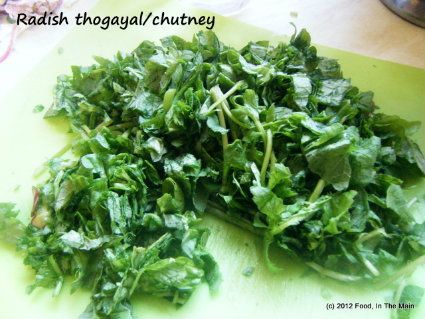
2 medium onions, chopped
5-6 dried red chillies (or to taste)
2 tbsp tur/toor/tuvar dal
3 tbsp urad dal

1 tbsp tamarind paste
a few fresh/frozen curry leaves
3 tsp oil
1/2 tsp asafoetida powder (optional)
Salt to taste
Method:
1. Heat 1 tsp oil in a pan, add the asafoetida powder and let it sizzle, then add the chopped onions and radish.
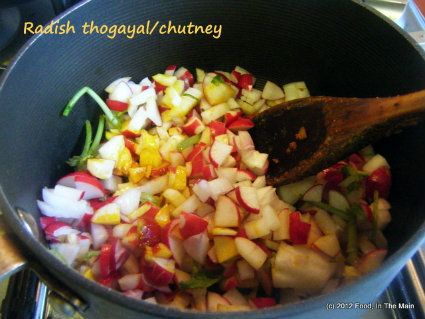
Stir-fry over medium heat for 3-4 minutes, until the radish is nearly cooked and the onions are turning soft (6-7 minutes).
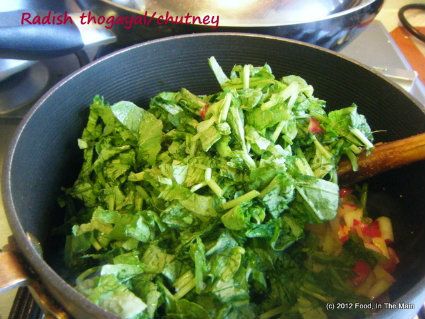 Add the chopped greens and cook till they wilt. Remove from the heat and let cool.
Add the chopped greens and cook till they wilt. Remove from the heat and let cool.
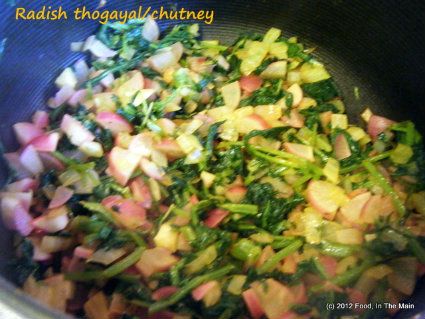 2. In another small pan, heat the remaining oil and add the red chillies, urad dal, toor dal and curry leaves.
2. In another small pan, heat the remaining oil and add the red chillies, urad dal, toor dal and curry leaves.
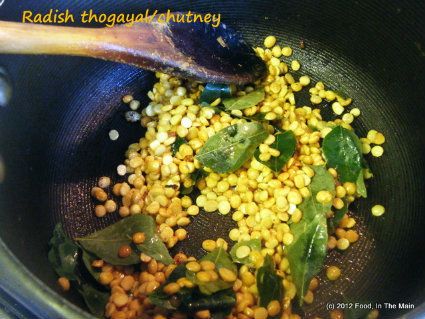 Fry, stirring, till the dals are golden brown and the red chillies turn a shade darker. Remove from the heat.
3. When all of it is completely cool, transfer to a mixie/grinder, add the tamarind paste and grind it to a fairly smooth mix.
Fry, stirring, till the dals are golden brown and the red chillies turn a shade darker. Remove from the heat.
3. When all of it is completely cool, transfer to a mixie/grinder, add the tamarind paste and grind it to a fairly smooth mix.
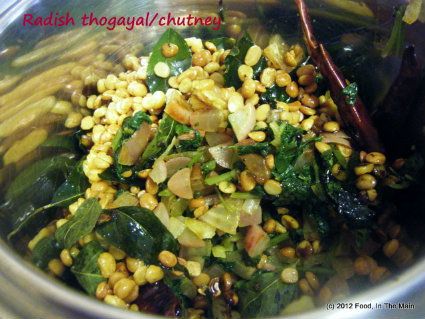 4. Add salt to taste and mix it in. Serve as a side dish with rice, chapaties, bread or as a dip with snacks.
RECIPE: RADISH THOGAYAL/CHUTNEY
4. Add salt to taste and mix it in. Serve as a side dish with rice, chapaties, bread or as a dip with snacks.
RECIPE: RADISH THOGAYAL/CHUTNEY
Ingredients:
10-12 small red radishes or 1 medium white mooli/radish, chopped
1 cup radish greens (or use spinach) (optional)
2 medium onions, chopped
5-6 dried red chillies (or to taste)
2 tbsp tur/toor/tuvar dal
3 tbsp urad dal
1 tbsp tamarind paste
a few fresh/frozen curry leaves
3 tsp oil
1/2 tsp asafoetida powder (optional)
Salt to taste
Method:
1. Heat 1 tsp oil in a pan, add the asafoetida powder and let it sizzle, then add the chopped onions and radish. Stir-fry over medium heat for 3-4 minutes, until the radish is nearly cooked and the onions are turning soft (6-7 minutes). Add the chopped greens and cook till they wilt. Remove from the heat and let cool.
2. In another small pan, heat the remaining oil and add the red chillies, urad dal, toor dal and curry leaves. Fry, stirring, till the dals are golden brown and the red chillies turn a shade darker. Remove from the heat.
3. When all of it is completely cool, transfer to a mixie/grinder, add the tamarind paste and grind it to a fairly smooth mix.
4. Add salt to taste and mix it in. Serve as a side dish with rice, chapaties, bread or even as a dip with snacks.
I think I may have found the most PERFECT masala recipe I've ever tried, and all thanks to Sangeeta of Banaras ka Khana blog. Her blog is one of my favourites, because she has North Indian recipes which are not so well known (at least to me) as the usual things you get endlessly everywhere. I like reading about typical everyday recipes which are still not common outside of individual homes, and Sangeeta's blog is the perfect place to find these.
I tried this masala with cooked chickpeas because I had some, and loved the result so much that I've made it (with different dals) four times in the last 10 days... although not (yet) with the original split chickpeas (or chana dal) that Sangeetha used. I've tried it both as a thick sauce and as a runnier one, and it makes not a whit of difference - other than the clingy sauce is better with whole chickpeas.
I reduced the peppercorns to 1/2 tsp because I can't take the heat from them (but chilli-heat is more than bearable, go figure), but otherwise the recipe is no different - well, apart from having used chickpeas, that is. Do try it - it's pretty quick to make, too, especially if you use canned chickpeas.
Recipe for: Chana bhuna
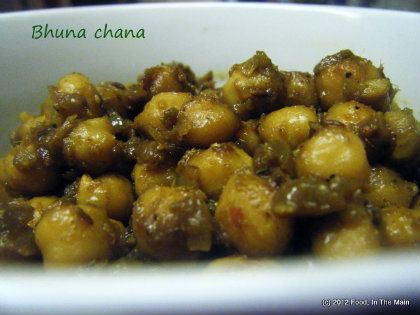
Ingredients:3-4 cups cooked chickpeas (or two cans' worth)
1 large onion, chopped fine
1 tbsp ghee or oil (I used oil)
1 tsp cumin seeds
Salt to taste
For grinding:

1/2" piece cinnamon stick
1 small black cardamom (seeds only)
1 htsp coriander seeds
1 htsp cumin seeds
2 cloves
4-5 dried red chillies (or to taste)
3 garlic cloves
1" ginger root
1/2 tsp black peppercorns
1/2 tsp turmeric powder
1/2 tsp amchoor (dried raw mango) powder - optional
3-4 tbsp water
Method:1. Grind all the ingredients for the masala into a smooth, fairly thick paste. Use only as much water as required to make it smooth.
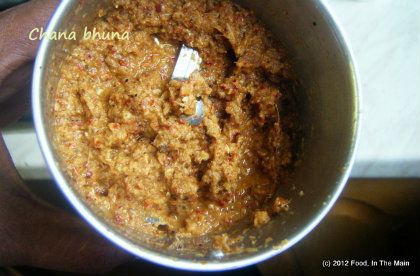
2. Heat the oil/ghee in a pan, then add the cumin seeds.
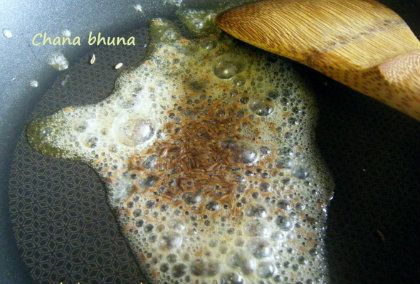
3. Once the seeds sizzle, add the chopped onion and stir.
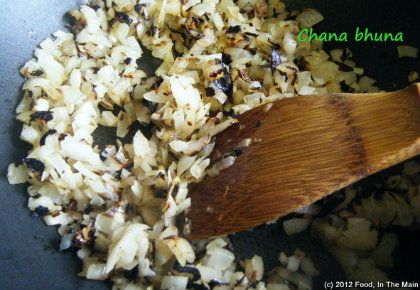
Let it cook on low heat for 15 minutes or so, till it becomes soft and pinkish.
4. Now add the ground masala paste to the cooked onion
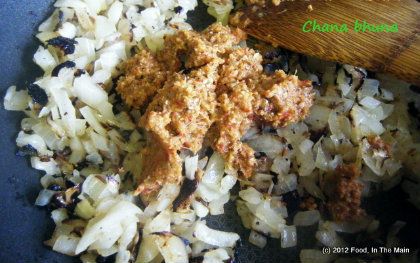
and stir it in.

5. Fry it (bhuno) on low heat for 5-7 minutes, stirring frequently, till the paste is well amalgamated, thick and intensely aromatic. Any excess water should have evaporated.
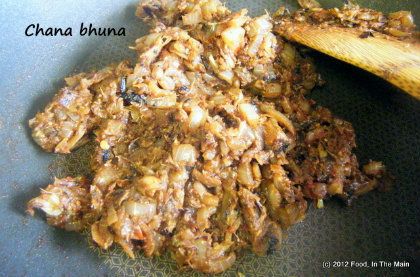
6. Now add the chickpeas along with salt to taste

and stir till it is all well mixed.
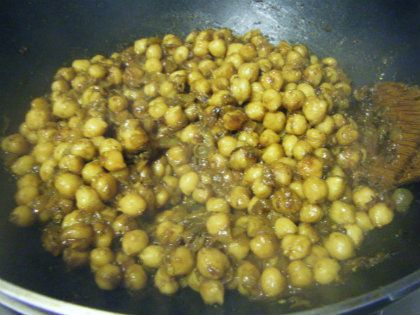
7. Let it cook for 2-3 minutes more (longer if it is watery), then take it off the heat.
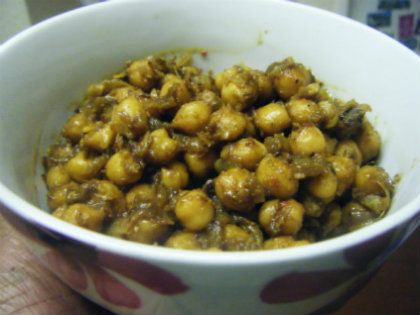
Serve hot with chapaties or puris.
Note: The curry tastes best when the masala coats the chickpeas thickly, so make sure the masala is not runny.
RECIPE: CHANA BHUNA
Ingredients:
3-4 cups cooked chickpeas (or two cans' worth)
1 large onion, chopped fine
1 tbsp ghee or oil
1 tsp cumin seeds
Salt to taste
For grinding:
1/2" piece cinnamon stick
1 small black cardamom (seeds only)
1 htsp coriander seeds
1 htsp cumin seeds
2 cloves
4-5 dried red chillies (or to taste)
3 garlic cloves
1" ginger root
1/2 tsp black peppercorns
1/2 tsp turmeric powder
1/2 tsp amchoor (dried raw mango) powder - optional
3-4 tbsp water
Method:
1. Grind all the ingredients for the masala into a smooth, fairly thick paste. Use only as much water as required to make it smooth.
2. Heat the oil in a pan, then add the cumin seeds.
3. Once the seeds sizzle, add the chopped onion and stir. Let it cook on low heat for 15 minutes or so, till it becomes soft and pinkish.
4. Now add the ground masala paste to the cooked onion and stir it in.
5. Fry it (bhuno) on low heat for 5-7 minutes, stirring frequently, till the paste is well amalgamated, thick and intensely aromatic. Any excess water should have evaporated.
6. Now add the chickpeas along with salt to taste and stir till it is all well mixed.
7. Let it cook for 2-3 minutes more, then take it off the heat. Serve hot with chapaties or puris.
Note: The curry tastes best when the masala coats the chickpeas thickly, so make sure the masala is not runny.
I'm sure that there are dozens of recipes for green rice Indian-style on the blogosphere, and dozens more if you were to look for "spinach rice" or "spinach pulao" or "spinach masala rice" or for any such combination that you care to come up with... but, like Frank Sinatra (much) before me, I didn't do it in any of those other dozens of ways - instead, I did it "Myyyyyy Waaaaaaayyy". Just be glad that I cooked it Myyyyyy Waaaaaaayyy, instead of singing it - I don't think that my singing would be particularly appreciated, whereas chances of my recipe being appreciated are quite good... or so I like to think. But, more importantly - what do YOU think?
Recipe for: Spinach black-sesame masala rice
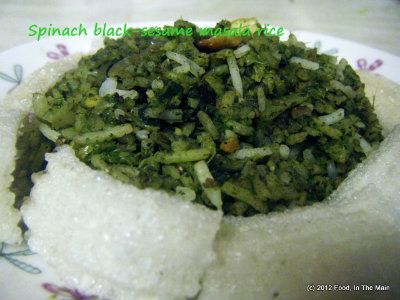
Ingredients:
4-5 cups basmati rice, pre-cooked al dente
1 cup shredded green cabbage (I used savoy)
1 large onion, sliced thinly
2 tbsp chopped mint
1 tbsp oil
1/2 tsp cumin seeds, crushed or left whole
1 tsp ghee
10-15 cashewnuts, broken, for garnish
a pinch of soda bicarb
Salt to taste
For the wet masala
1 cup chopped spinach, loosely packed
1 cup chopped coriander leaves, loosely packed
4-5 green chillies (or as per taste)
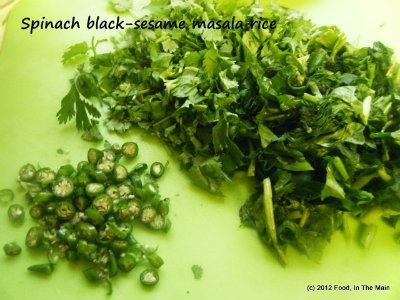
1" piece ginger
For the dry masala
1 tbsp coriander seeds
1 tbsp black sesame seeds
1 tbsp tur dal
2-3 dry red chillies (optional)
Method:
1. Grind all the ingredients for the wet masala to a smooth paste and set aside till required.
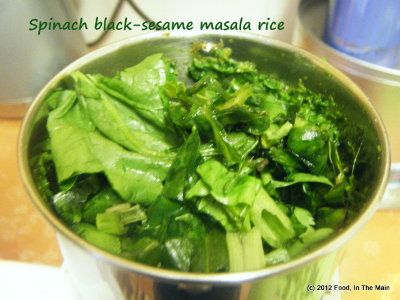
Do not add any extra water while grinding.
2. Dry-roast the dry masala ingredients in a small pan over medium heat,

stirring frequently, till they are aromatic and the dal is golden brown. Do not let them burn. When cool, grind them to a powder (doesn't have to be very smooth) and reserve.
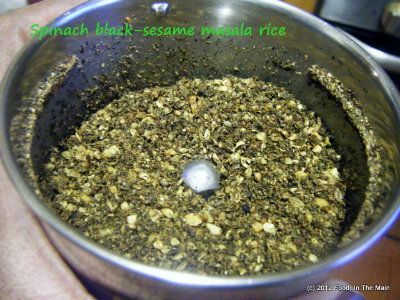
3. Heat the ghee in a big kadai or wok and fry the cashew nuts till they are a pale golden brown. Remove from the pan and set aside till required.
4. In the same pan, heat the 1 tbsp oil. Add 1/2 tsp cumin seeds and let them sizzle for 10 seconds, then add the sliced onion.
5. Fry 2-3 till they begin to soften, then add the cabbage.

Stir well, then cover the pan tightly and let the cabbage cook till nearly done, about 7 minutes.
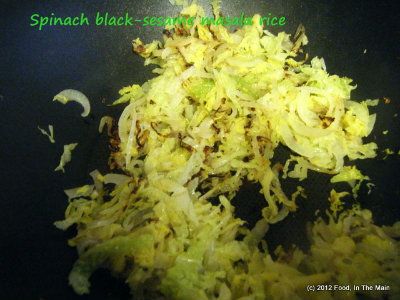
6. Now add the ground spinach masala with a pinch of soda bicarb and fry it for about 5-6 minutes, stirring,
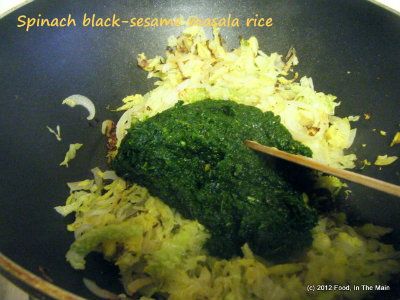
until it loses most of the excess moisture and doesn't smell raw any more.

7. Add the cooked rice now, along with salt to taste,
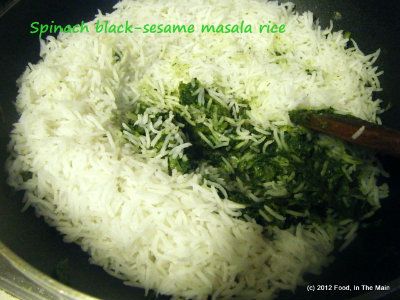
and mix it in carefully with the masala, without mushing up the grains,
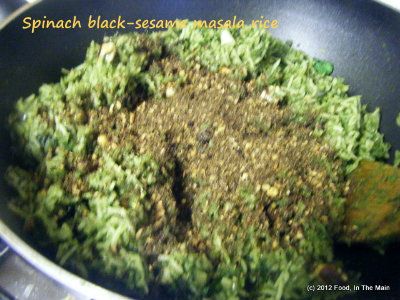
then stir in the dry masala powder.
8. Sprinkle the chopped mint and fried cashewnuts over the rice,
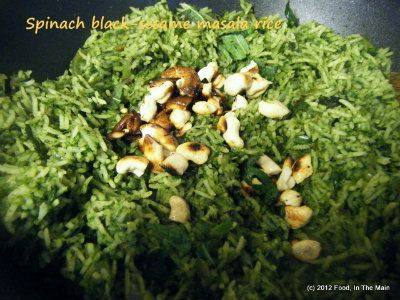
and serve hot along with fried papad/appalam or potato crisps, and onion raita.
RECIPE: SPINACH BLACK-SESAME MASALA RICE
Ingredients:
4-5 cups basmati rice, pre-cooked al dente
1 cup shredded green cabbage (I used savoy)
1 large onion, sliced thinly
2 tbsp chopped mint
1 tbsp oil
1/2 tsp cumin seeds, crushed or left whole
1 tsp ghee
10-15 cashewnuts, broken, for garnish
a pinch of soda bicarb
Salt to taste
For the wet masala
1 cup chopped spinach, loosely packed
1 cup chopped coriander leaves, loosely packed
4-5 green chillies (or as per taste)
1" piece ginger
For the dry masala
1 tbsp coriander seeds
1 tbsp black sesame seeds
1 tbsp tur dal
2-3 dry red chillies (optional)
Method
1. Grind all the ingredients for the wet masala to a smooth paste and set aside till required. Do not add any extra water while grinding.
2. Dry-roast the dry masala ingredients in a small pan over medium heat, stirring frequently, till they are aromatic and the dal is golden brown. Do not let them burn. When cool, grind them to a
powder (doesn't have to be very smooth) and reserve.
3. Heat the ghee in a big kadai or wok and fry the cashew nuts till they are a pale golden brown. Remove from the pan and set aside till required.
4. In the same pan, heat the 1 tbsp oil. Add 1/2 tsp cumin seeds and let them sizzle for 10 seconds, then add the sliced onion.
5. Fry 2-3 till they begin to soften, then add the cabbage. Stir well, then cover the pan tightly and let the cabbage cook till nearly done, about 7 minutes.
6. Now add the ground spinach masala with a pinch of soda bicarb and fry it for about 5-6 minutes, stirring, until it loses most of the excess moisture and doesn't smell raw any more.
7. Add the cooked rice now, along with salt to taste, and mix it in carefully with the masala without mushing up the grains, then stir in the dry masala powder.
8. Sprinkle the chopped mint and fried cashewnuts over the rice, and serve hot along with fried papad/appalam or potato crisps, and onion raita.
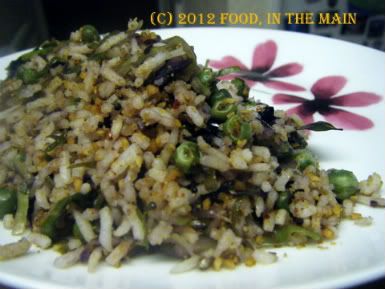 Cabbage is one of my favourite vegetables, pretty much no matter how it’s cooked – as long as that doesn’t mean cooking it to a stinky sulphur-y mush. I don’t care much for white cabbage, because (in my opinion) it’s stinkier and sulphur-ier than green cabbage. (It might not be any more or less smelly, you understand - I’m just quoting the opinion put forward by my nose). Purple cabbage is kinda like white cabbage except purple… and because it’s a pretty colour for cabbage, I don’t shun it.
But the cabbage I use the most is a pointy, tear-drop shaped green cabbage marketed under the name “sweetheart cabbage” in the supermarkets here. That said, I quite like the round green kind too. But sweetheart by name, sweetheart by taste – no, ok, that simile doesn’t work. There’s a good reason I’m not a world-famous writer, I suppose.
Anyway, those are the three types of cabbage available - unless you count the round green cabbage as a different variety from the pointy green one… in which case, the cabbage count goes from three to four. I’m sure that, like potatoes, there are hundreds of different varieties of cabbage, all of which have individual names, again like potatoes. I probably just don’t know about them.
Cabbage is one of my favourite vegetables, pretty much no matter how it’s cooked – as long as that doesn’t mean cooking it to a stinky sulphur-y mush. I don’t care much for white cabbage, because (in my opinion) it’s stinkier and sulphur-ier than green cabbage. (It might not be any more or less smelly, you understand - I’m just quoting the opinion put forward by my nose). Purple cabbage is kinda like white cabbage except purple… and because it’s a pretty colour for cabbage, I don’t shun it.
But the cabbage I use the most is a pointy, tear-drop shaped green cabbage marketed under the name “sweetheart cabbage” in the supermarkets here. That said, I quite like the round green kind too. But sweetheart by name, sweetheart by taste – no, ok, that simile doesn’t work. There’s a good reason I’m not a world-famous writer, I suppose.
Anyway, those are the three types of cabbage available - unless you count the round green cabbage as a different variety from the pointy green one… in which case, the cabbage count goes from three to four. I’m sure that, like potatoes, there are hundreds of different varieties of cabbage, all of which have individual names, again like potatoes. I probably just don’t know about them.
So, coming back to what I do know (a much shorter topic, haha), which is that I love cabbage, what I made with a combination of green and purple cabbage was a luvverly rice dish. With added peas. There's hardly anything that doesn't benefit from the addition of peas, unless it's a cake. Although I bet someone somewhere has tried a green peas cake and written about it on their blog... Ok, I'm off to google for green peas cake now, but you please feel free to read my recipe below and try it out, because it's really, really tasty - especially if you're a cabbage enthusiast like me.
Recipe for: Cabbage and peas rice
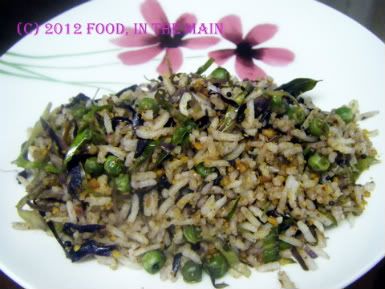 Ingredients:
Ingredients:
2 cups cooked basmati rice
3 cups cabbage, finely shredded
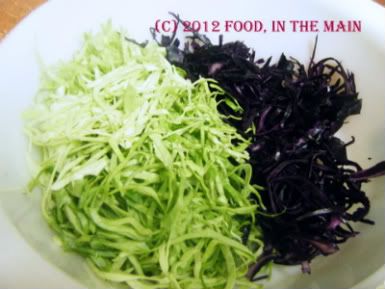 1/2 cup peas (fresh or frozen)
1 tsp oil
2 tsp mustard seeds
1/4 tsp asafoetida powder
a few fresh/frozen curry leaves
Salt to taste
Peanuts and chopped coriander leaves for garnish (optional)
1/2 cup peas (fresh or frozen)
1 tsp oil
2 tsp mustard seeds
1/4 tsp asafoetida powder
a few fresh/frozen curry leaves
Salt to taste
Peanuts and chopped coriander leaves for garnish (optional)
For the masala powder:
1/2 tsp oil
1 htsp urad dal
1 htsp tuvar dal
1 htsp chana dal
1 htsp coriander seeds
4-5 dried red chillies (or to taste)
2 tbsp shredded fresh or dry coconut
Method:
1. Heat 1/2 tsp oil in a large pan.  Fry the masala powder ingredients (bar the coconut) over a low flame till the dals turn a pale golden brown, and the chillies are a shiny dark red. Remove to a plate and let cool.
2. Grind the cooled roasted dals along with the coconut to a fairly smooth powder.
Fry the masala powder ingredients (bar the coconut) over a low flame till the dals turn a pale golden brown, and the chillies are a shiny dark red. Remove to a plate and let cool.
2. Grind the cooled roasted dals along with the coconut to a fairly smooth powder.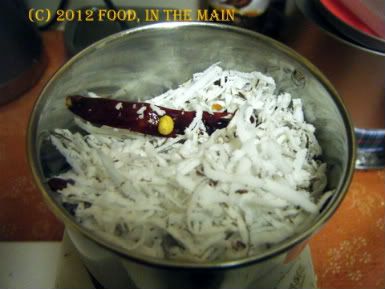 Reserve.
Reserve.
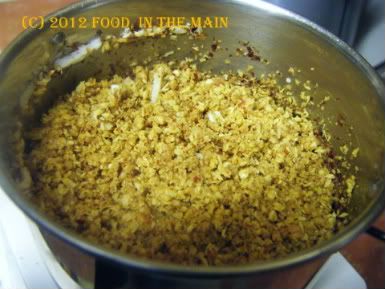 3. Heat the remaining oil in the same pan and add the asafoetida powder, curry leaves and mustard seeds. Cover the pan and let the seeds pop.
3. Heat the remaining oil in the same pan and add the asafoetida powder, curry leaves and mustard seeds. Cover the pan and let the seeds pop.
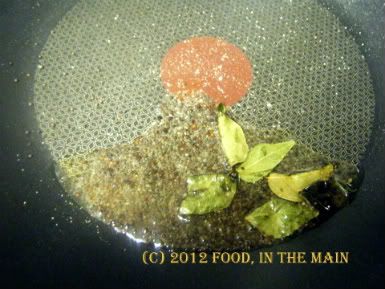 4. Now add the shredded cabbage and peas and stir well.
4. Now add the shredded cabbage and peas and stir well. 
Cover the pan tightly and let the vegetables cook on a very low heat for about 7 minutes, till the cabbage is cooked but still retains some bite.
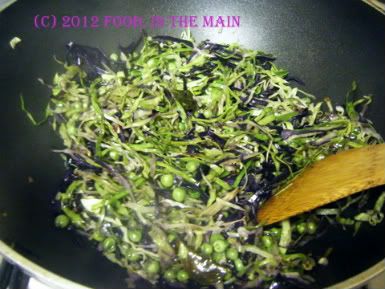 5. Once the cabbage is done, add the ground coconut masala powder and salt to taste, and mix well.
5. Once the cabbage is done, add the ground coconut masala powder and salt to taste, and mix well.
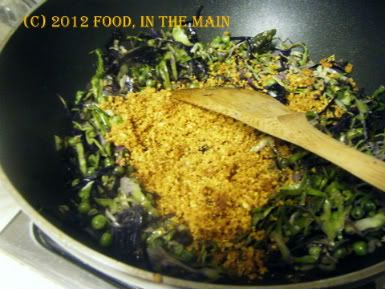
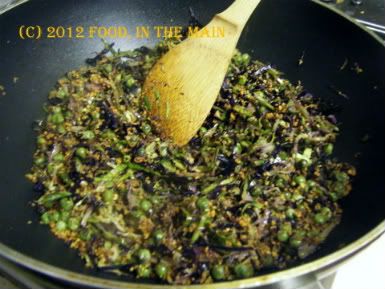 6. Then add the rice and mix it in carefully until it is distributed evenly.
6. Then add the rice and mix it in carefully until it is distributed evenly. 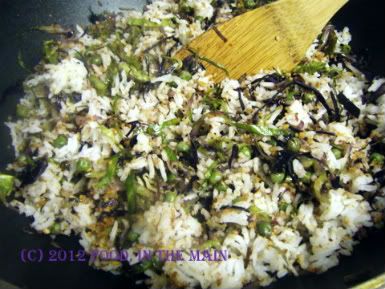
Add the chopped coriander (if using) and scatter the roasted peanuts over. Serve hot with cucumber raita and papad or crisps on the side.
RECIPE: CABBAGE AND PEAS RICE
Ingredients:
2 cups cooked basmati rice
3 cups cabbage, finely shredded
1/2 cup peas (fresh or frozen)
1 tsp oil
2 tsp mustard seeds
1/4 tsp asafoetida powder
a few fresh/frozen curry
Salt to taste
Peanuts and chopped coriander leaves for garnish (optional)
For the masala powder:
1/2 tsp oil
1 htsp urad dal
1 htsp tuvar dal
1 htsp chana dal
1 htsp coriander seeds
4-5 dried red chillies (or to taste)
2 tbsp shredded fresh or dry coconut
Method:
1. Heat 1/2 tsp oil in a large pan and fry the masala powder ingredients (bar the coconut) over a low flame till the dals turn a pale golden brown, and the chillies are a shiny dark red. Remove to a plate and let cool.
2. Grind the cooled roasted dals along with the coconut to a fairly smooth powder. Reserve.
3. Heat the remaining oil in the same pan and add the asafoetida powder, curry leaves and mustard seeds. Cover the pan and let the seeds pop.
4. Now add the shredded cabbage and peas and stir well. Cover the pan tightly and let the vegetables cook on a very low heat for about 7 minutes, till the cabbage is cooked but still retains some bite.
5. Once the cabbage is done, add the ground coconut masala powder and salt to taste, and mix well.
6. Then add the rice and mix it in carefully until it is distributed evenly. Add the chopped coriander (if using) and scatter the roasted peanuts over. Serve hot with cucumber raita.






















































